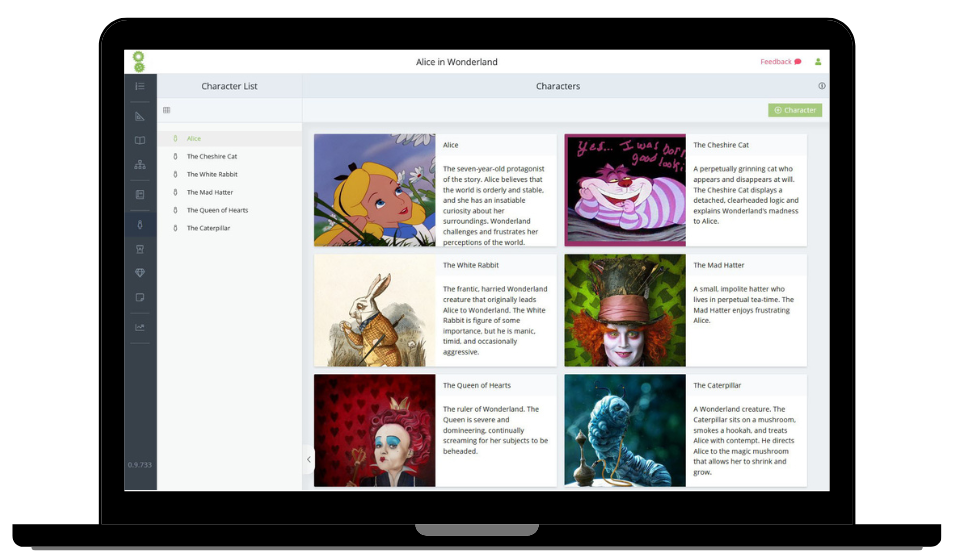
What is a Round Character?
What do people mean when they talk about Round Characters?
We instinctively feel Round Characters must be good things to have in our novels, but what makes a Round Character different from a Flat Character? And where do Dynamic and Static characters fit in?
Should all your characters be Round?
How do you make them Round in the first place?
In this article we’re going to explore all these questions.
Here’s what we’ll cover:
- A Round Character definition
- Round Characters versus Flat Characters
- Round Characters versus Dynamic characters
- How to Write a Round Character
- Examples of Round Characters from popular books and movies
- Tasks to help you develop your own Round characters
Let’s get started!
Round Character Definition
The most basic definition of a Round Character is a character who feels like a real person – someone with desires, memories, flaws, prejudices, inconsistencies and mannerisms.
The term ’round character’ originally comes from E. M. Forster in his 1927 book The Aspects of the Novel:
The test of a round character is whether it is capable of surprising in a convincing way. If it never surprises, it is flat. If it does not convince, it is flat pretending to be round. [A round character] has the incalculability of life about it—life within the pages of a book.
Forster makes two main assertions:
- If a character never surprises, it is flat.
- If it surprises, but does not convince, it is flat pretending to be round.
Let’s examine each of these.
If it does not surprise, it is flat.
We could define a character who never surprises as one who fits into a stereotype we’re used to seeing every day, and have a number of preconceptions about. If they meet all the preconceptions and never do anything else, they will never surprise us.
For example, the ‘overbearing father,’ a common stereotypical character. If this character is shown to meet our preconceptions by being bullish, demanding and shouty, he behaved entirely as predicted, and the character feels two dimensional.
However, if the overbearing father is revealed to be tender and affectionate toward the pet cat, or to have a weakness for mint chocolate chip ice cream, then this does not fit our preconceived ideas.
We are surprised, and this makes us feel like this character might have more going on under the surface than we realised.
If it surprises but does not convince, it is flat pretending to be round.
But as Forster says, these surprises need to be convincing. If the father’s affection for the cat or ice cream feels jarring or arbitrary to the reader, he won’t feel like a Round Character, but like a Flat Character with some sequins glued on.
Comparing Flat and Round Characters
Here are some very simplistic examples of how a character can shift from being Flat to Round, although for a truly Round Character you will obviously need to go into a lot more depth.
Flat: A high school bully
Round: A high school bully who secretly befriends a street fox because he feels like an outcast in his own home.
Flat: A headstrong Prime Minister
Round: A headstrong Prime Minister who can be made to feel like a helpless little girl with just a few words from her manipulative father.
Flat: A young girl who loves horses
Round: A young girl who loves horses because she dreams of becoming a courageous knight.
Round Characters Versus Flat Characters
As we’ve described above, a Round Character is someone who breaks out of their stereotype. By contrast, a Flat Character tends to stay within the bounds of their stereotype.
In most cases, stories feel more satisfying if the main characters are Round and feel like real people to the reader. But that doesn’t mean every character needs to be Round.
In real life, we get to know our closest friends, seeing them as ’round,’ but life would be overloaded if we got to know every single person we met in that way. We have plenty of interactions with the postman, the shopkeeper, the fellow dog walker and never learn more about them.
Of course, if we think about it we realise the postman is also a father, and may have recently fallen out with his best friend, and is still haunted by a humiliating experience in primary school. But we don’t have the time or mental capacity to learn the full lives of everyone we encounter.
So, he remains just the postman, and that’s enough.
Similarly, there will likely be too many characters in your novel to build every one as a Round Character. If you did, it would most likely add unnecessary confusion and complexity to the story.
Many secondary characters are fine to leave Flat—they may represent a particular thing, and keeping them simple gives the story clarity.
Round Characters Versus Dynamic characters
It’s useful to understand the difference between Round and Dynamic Characters, as these terms are sometimes confused.
While the definition of a Round Character is someone who is complicated, the definition of a Dynamic Character is someone who changes.
You can have a perfectly formed, living, breathing character who leaps off the pages, but doesn’t change throughout the story.
Likewise, you could have a character who undergoes an emotional evolution through a story, but isn’t depicted with enough complexity for readers to feel they have come to life.
Note: The opposite of a Dynamic Character is a Static Character—meaning they don’t change. A Static Character can be either Flat or Round.
How to Write a Round Character

There are several ways to add complexity and depth to your characters to lift them into three dimensions.
Here are a few approaches — ideally you would combine as many of these as possible into a coherent whole:
Show aspects of the character which are surprising or unusual.
As described above, people can often be defined by a basic role, or possibly age, gender, and job. If you can take this core and add details which traditionally don’t fit with that stereotype, then you’ve made a start on giving them the complexity you find in a real person.
This could be something major, which is in direct opposition to the stereotype, like having a fat cat CEO who is actually motivated by love rather than greed, or a little ballerina girl who is always getting into punch ups instead of behaving with delicacy and decorum.
Or, it could be a smaller detail, such as a strict matron who loves wearing unicorn socks, or a vampire who works as a photo-journalist.
Highlight motivations and internal conflicts.
Real people have desires. Often these desires are complicated and inconsistent.
For example, you might want to be fit and healthy, but the thought of going to a gym brings you out in hives. Or, you might want to be a kind, consistent parent, but the children won’t listen no matter what you do. They’re constantly bickering, you get little sleep, and you can’t help but lose your temper. Again.
Identifying the central drives of your main characters can go a long way in bringing them to life. If you can develop several desires which are in conflict with each other, the characters will have greater depth.
Give the character relatable flaws.
Most of us are painfully aware of our own shortcomings (or if anyone isn’t, that is most certainly a flaw), so we would be highly suspicious of a character who didn’t seem to have any. A perfect character is never realistic.
So gift your character with a bundle of flaws, ranging from the trivial to the potentially tragic.
They may sometimes miss their mouth when eating, or they may be blindly egotistical. Perhaps they’re terrified of spiders, or have a misplaced hatred of music.
Bring the backstory to life.
Our personalities don’t pop out of nowhere, and neither should your characters’.
Our fears, mannerisms, eccentricities and preferences all develop slowly from the day we are born. Our feelings about the world are based on how we felt as a child. Our reactions to certain types of people and situations grow from previous encounters with those types.
By investigating your character’s history, you can help ensure the surprising parts of their character are justified, by being born out of their experiences.
Round Character Examples
Rachel Watson From Girl on the Train
Rachel’s character is almost entirely defined by her flaws – she appears to have thoroughly failed at life. Her alcoholism has cost her a marriage and her career, and now she has no prospects, and spends her time riding aimlessly on a train, spying on unsuspecting couples.
Her motivation is to find out the truth of what happened to her neighbour, Megan, but she’s riddled with internal conflict in the form of self-doubt, and the misconceptions she has about her own past.
We learn that Rachel is unable to have children, which is part of her backstory that initiated her alcoholism.
Rachel doesn’t fit the stereotype of ‘alcoholic,’ which generally gives us an image of an unkempt old man in a vest on a park bench (obviously this doesn’t reflect the reality of alcoholism, but it’s one of the first images most of us will envision).
Here’s some additional Reading on Rachel’s character.
Renton From Trainspotting
Renton’s motivations and internal conflicts are powerful, and central to the story.
As a drug addict, he constantly craves his next hit, but as he sees heroin destroying the lives of those around him, he knows he needs to get clean.
Renton’s many flaws are prominent. He’s selfish and nihilistic, and he’s willing to rob and cheat innocent people in pursuit of his beloved drug. His backstory is where the surprise element of Renton’s character really kicks in.
The stereotypical heroin addict comes from a poverty stricken, broken family, probably living on a council estate. However, Renton is revealed to come from a healthy, middle-class home, with two parents who love and support him.
Here is a great article exploring more of what makes Renton fascinating.
Daenerys Targaryen From Game of Thrones
Daenyrys appears to us as a stereotypical downtrodden girl. She’s meek, and trails after her egotistical brother, barely saying a word.
But through the books, she breaks out of her stereotype by passing initiation rites such as eating a raw heart and becoming a defiant and forceful leader.
At first, she’s motivated by a desire to please her brother, but this conflicts with her own need for self-preservation and self-respect, and not being treated as property.
As the books progress, she is motivated by the belief that she is the rightful heir to the throne. This conflicts with her desire to protect and save oppressed slaves.
Her power is matched by her flaws. She can be arrogant, willfully naive, and is constantly fighting the urge to just get on her dragon and unleash hell.
Here is a great article exploring Daenyrys in greater detail.
Create Your Own Round Characters
Hopefully this is a useful explanation of Round characters, how to create them, and when to use them.
Now it’s time to put this knowledge into action.
Here are some brainstorming ideas and scene writing tasks to help you develop your Round characters:
- In what surprising ways does your character break out of their stereotype? Write a scene where they display traits that contrast with their stereotype.
- List several desires the character has and consider situations where they could come into conflict. Write a scene involving one of these conflicts.
- Think about your character’s flaws – can you ensure they have at least one major and one minor flaw? Write a scene where the character faces a challenge that most people might not find that difficult, but is excruciating because of a flaw.
- Spend some time exploring your character’s backstory. Write a scene from their childhood that was important in forming some of their current views.
For more detailed advice on how to build a detailed, round character, check out this article on character development, which covers voice, backstory and character questionnaires.
If you liked this article, please share it and say hi to us on social media 🙂
Unlock your writing potential
If you liked this article by the Novel Factory, then why not try the Novel Factory app for writers?
It includes:
- Plot Templates
- Character Questionnaires
- Writing Guides
- Drag & Drop Plotting Tools
- World Building resources
- Much, much more

